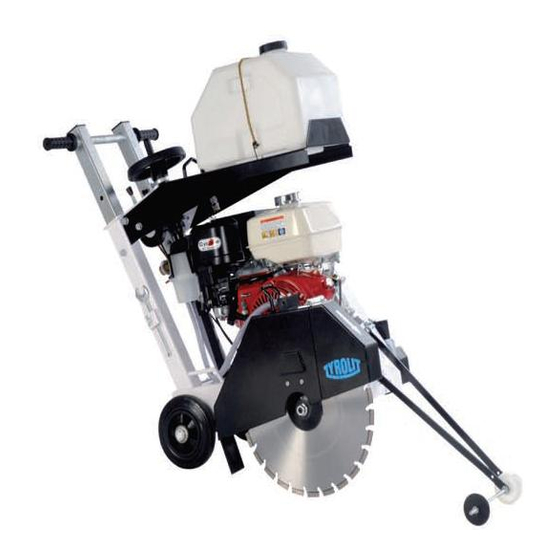Summary of Contents for TYROLIT Hydrostress FSG513P
- Page 1 Operating Manual Spare Parts List ————————————————————————— Floor Saw FSG513P Index / Indice 004 10997588 en / 31.08.2016...
- Page 2 Tel. +41 (0)44 952 18 18 Fax +41 (0)44 952 18 00 www.tyrolit.com TYROLIT Hydrostress AG reserves the right to make technical changes without prior notice. Copyright © 2005 TYROLIT Hydrostress AG, CH-8330 Pfäffikon ZH, Switzerland All rights reserved, in particular copyrighting and translating rights.
-
Page 3: Table Of Contents
Preface to the operating manual This operating manual makes it easier to become familiar with the machine and to use it properly. The operating manual contains important information on how to operate the machine safely, properly and efficiently. Following the operating manual helps avoid danger, reduce repair costs and downtime, and increase the machine's reliability and life. -
Page 4: Basic Safety Instructions
1. Basic safety instructions 1.1 Warning and symbols in the manual Danger! Points out that serious or even fatal injuries may result if not followed. Caution! Points out that injuries may result if not followed. Notice! Points out that damage to the machine or other equipment may result if not followed. - Page 5 1.3.8 In the event of safety-relevant changes to the machine or its operating performance, stop the machine immediately and report the malfunction to the responsible authority/ person! 1.3.9 Do not make any modifications to the machine, add attachments, or reconfigure it without the supplier’s permission! 1.3.10 Only use manufacturer’s original parts!
- Page 6 1.5 Safety instructions during specific operating phases 1.5.1 Normal operation 1.5.1.1 Avoid all working methods which may compromise safety. 1.5.1.2 Take steps to ensure that the machine is operated only in a safe and proper condition! 1.5.1.3 Check the machine for visible external damage and defects at least once per shift! Immediately report any changes (including in operational performance) to the responsible department/individual! If necessary, stop the machine immediately and secure it.
- Page 7 1.6 Notice on specific hazard types 1.6.1 Electricity 1.6.1.1 Only use original fuses with the specified amperage! If the electrical power supply is interrupted, shut down the machine immediately! 1.6.1.2 Work on electrical equipment may only be carried out by electricians or by trained persons under the guidance and supervision of an electrician in accordance with electrical regulations.
-
Page 8: Machine Description
2. Machine description 2.1 Overview of components Item 1 - Saw blade protective hood Item 2 - Petrol motor Item 3 - Steering rod Item 4 - Frame Item 5 - Water tank Item 6 – Cut indicator... - Page 9 2.2 Protective equipment Item 1 - Saw blade protective hood 2.3 Technical data FSG513P Max. Cutting depth 170 mm Max. saw blade diameter 450 mm Saw blade receptacle 25.4 mm Drive motor 1-cylinder Honda Performance (kW/PS) 8.0 kW/ 10.9 PS...
-
Page 10: Placement In Operation
3. Placement in operation 3.1 Connections and fuel − Use regular petrol (unleaded) − Connect cooling water hose or fill water tank 3.2 Water supply − Connect the external water hose to the connecting piece of the floor saw − Connect the water tank`s connecting piece for diamond blade cooling 3.3 Saw blade installation −... -
Page 11: Transport
4. Transport 4.1 Transport position means: Attention! Do not tip Floor Saw (motor oil will run into the combustion chamber) − The motor is turned off − Saw arm is in horizontal position 4.2 Movement with crane − Remove water tank −... -
Page 12: Operation
5. Operation 5.1 Normal cutting operation − Initiate feed movement through steering rod − Adjust feed speed to the feed force − If feed force is too great, you must check the following points: * Saw blade dull? * Too little cooling water? * Saw blade choice correct? * Is the motor producing its full power or speed? −... -
Page 13: Repair Of Malfunctions
6.2 Fuel / Lubricant − Petrol motor – see Honda operating manual − Lubricate bearings * Energrease LS2 BP IMPORTANT We hereby advise that damage occurring within the motor’s warranty period may be repaired only by an authorized service partner (see service directory for motor)! 7. -
Page 14: Warranty
Immediately upon a defect being discovered, the machine and/or the affected parts must be sent for repair or replacement to TYROLIT Hydrostress AG or a local authorised TYROLIT Hydrostress AG branch office. - Page 15 TYROLIT Hydrostress AG Wearing Part Terms Wearing parts are those parts which are subject to operational wear and tear when the machine is used correctly. The wear period depends on the individual duration and intensity of use. The wearing parts must be maintained, adjusted and if necessary replaced according to the manufacturer's operating instructions or handed over to the Service Center of TYROLIT Hydrostress AG for maintenance according to the operating instructions.
-
Page 16: Declaration Of Conformity
FSG513P Article number: 10988500 10988800 Index Year of construction: 2010 The TYROLIT Hydrostress AG certifies that the inspected above machine against the following guidelines and that we confirm compliance with these standards: Guidelines: Machine Directive 2006/42/CE Noise Emission 2000/14/CE Standards:...

















Need help?
Do you have a question about the FSG513P and is the answer not in the manual?
Questions and answers